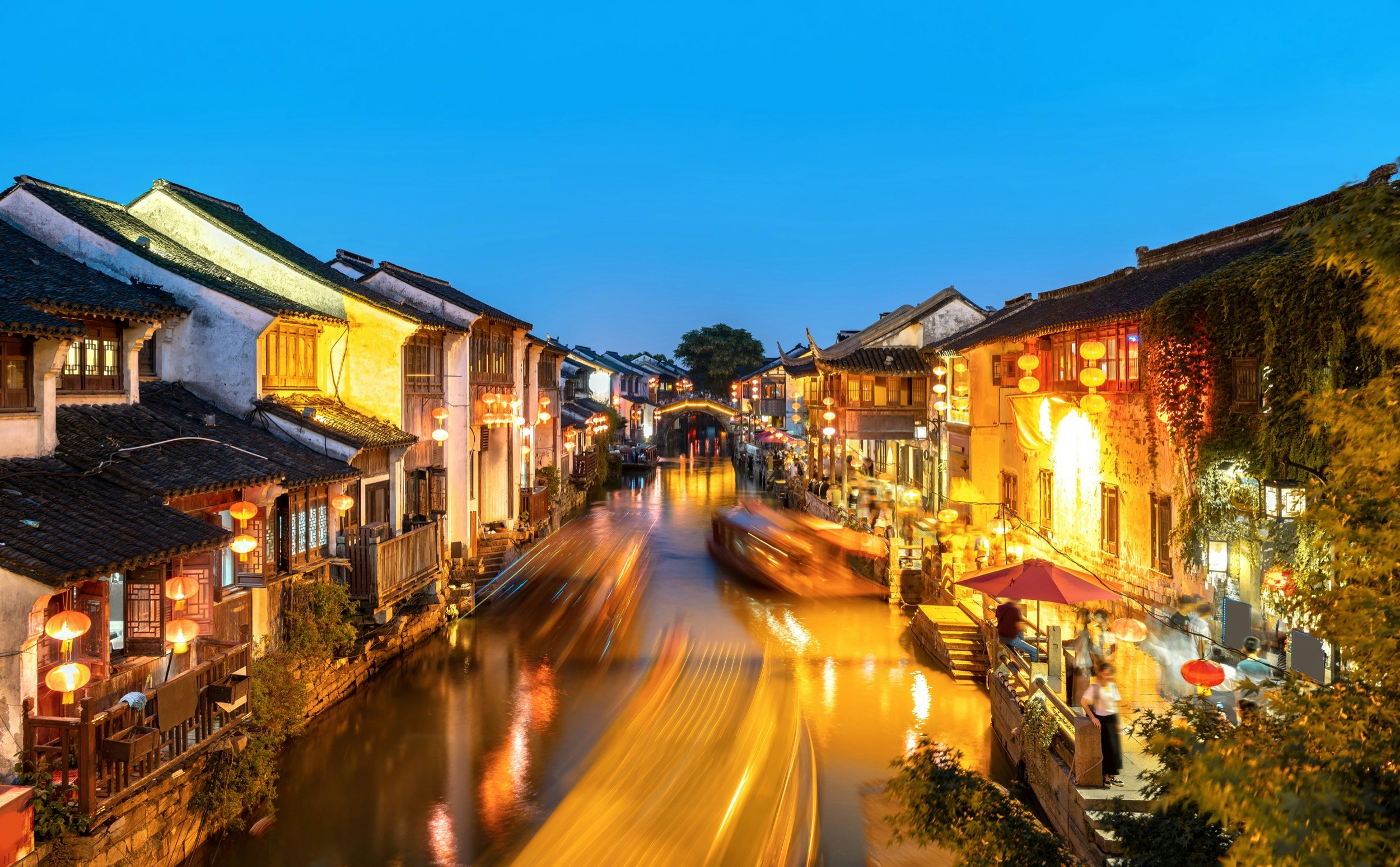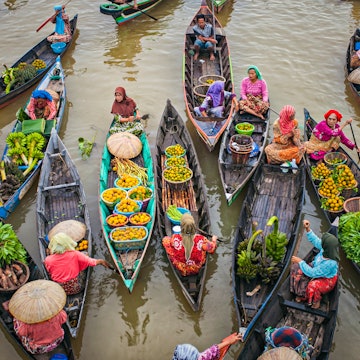
Jiangsu Province: Welcome to the Land of Water
Sponsored by

Jun 2, 2022 • 6 min read

A special harmony between water and people endures in canal cities like Suzhou and the many idyllic water towns dotted throughout southern Jiangsu © Hung Chung Chih / Shutterstock
Jiangsu, one of the most populous and prosperous provinces in China, has long been known as shui xiang, ‘the land of water.’
Crisscrossed by sparkling tributaries, lakes, and manmade canals, including China’s venerable Grand Canal, the vast and fertile Yangtze River delta has been one of the richest regions in China, both materially and culturally, since the Eastern Han dynasty.
The lower reaches of the Yangtze itself, Asia’s longest river, meander through the south of the province – the final leg of its epic, 4,000-mile journey from the snow-capped Qinghai-Tibet plateau to the East China Sea.
Because of the historic importance of these waterways, a special harmony between water and people endures in canal cities like Suzhou, famed as the ‘Venice of the East’, and the many idyllic water towns dotted throughout southern Jiangsu.

The Grand Canal
Historically, Jiangsu’s prosperity owes much to the Grand Canal, the more than 1,000-mile waterway that promoted the economic development of cities like Suzhou, Yangzhou and other destinations throughout the province.
First completed in the Sui Dynasty (581-618 AD), the Grand Canal was conceived as a source of life-giving growth. It was built to ship grain from the fertile Yangtze Delta northward to places like Beijing, on the upper reaches of the arid Huabei plain. This movement of food and resources led to population expansion.
Though large stretches of the Grand Canal have long since silted over, you can see sections of the ancient trade route still operating today in Suzhou. Baodai Bridge, a Ming-era causeway, is one such spot, crossing the Grand Canal southeast of Suzhou’s historic core, where modern cargo boats and industrial barges float placidly past its 53 stone arches.

Yangzhou, trove of Chinese culture
Another Jiangsu city known for its waterways and gardens is Yangzhou. Helped by its position on the Grand Canal, Yangzhou was a major center for salt and silk, as well as grain, ceramics and tea. Aside from strolling along timeworn cobbled streets, checking out historic gardens and tucking into exquisite Huaiyang cuisine, any trip to Yangzhou isn’t complete without a visit to its standout tourist sight, Slender West Lake.
This water feature, originally part of a river, was funded during the Qing dynasty by the city’s wealthy salt merchants. Located in the northwest of Yangzhou city, Slender West Lake is curved and narrow. The lake is set within a bucolic park planted with willows and bamboo, where bowed bridges hop over narrow channels, and pavilions serve traditional green tea.
One much-visited spot at the lake is said to be where the emperor enjoyed a successful fishing excursion. The story goes that local swimmers were diving underwater to attach fish to his hook. This charm offensive must have had a positive effect, because Yangzhou prospered to the end of the dynasty and beyond.
Culture, Craft and Beauty – A Week in Jiangsu Province

Suzhou – heaven on earth
Historic Nanjing, with its prize perch on the Yangtze, is Jiangsu’s capital and an important city, but when it comes to water, it’s Suzhou that captures the plaudits. One of the oldest cities in the Yangtze basin, Suzhou flourished early as a center of shipping and grain storage, bustling with merchants and artisans. Later, Suzhou was a major silk producer supporting a wealthy scholar class that built fine houses and exquisite gardens, many of which can still be visited today.
An historic core of old waterways, camel-humped bridges and antique residences, hemmed in on four sides by a buzzy, high-rise metropolis, presents a window onto Jiangsu’s timeless waterside customs. Wander along Pingjiang Lu, a cobbled lane following the course of a narrow canal, and you’ll pass lively cafes and teahouses with waterfront seating. But venture into the quieter side alleys and you might still spot locals using the waters to wash clothes, catch a fish, or journey by boat.

Tongli water town
Continuing south from Baodai Bridge, the old canals wend their way to Tongli, one of the loveliest water towns in Jiangsu province. Fed by five adjacent lakes, Tongli has canals where other towns have roads, and almost every residence – with an agreeably monochrome tailoring of black tiled eaves and whitewashed walls – peers out over water. Tongli was established in the Song Dynasty (960–1279 AD), though many of its finest attractions, such as Tuisi Garden, are of later Ming and Qing origin.
Dozens of stone bridges hug the narrow waterways, meaning there’s an Instagram-worthy vista around every corner. The most famous are a trio of bridges – Taiping, Jili and Changqing. It was once customary for a bride to cross all three in a sedan chair to seek blessing for the marriage.
The best way to savor Tongli’s timeless scenery, of course, is by boat; visitors can hire slow-moving rowboats for 25-minute tours.
Hike into History: Exploring Nanjing’s incredible city wall

Treasures of Zhouzhuang
The lotus-leaf-shaped town of Zhouzhuang, northeast of Tongli, has been wistfully called ‘the Land of Rivers and Lakes’ for centuries. Relaxing in a canal-side teahouse, nibbling qingtuan (a sweet dumpling made with glutinous rice and dyed green with Chinese herbs) is the quintessential Zhouzhuang experience. As willows trail their fronds in the water, and boats dip beneath weathered stone bridges, a timeless scene unfolds, one that has inspired artists and poets for centuries.
Most recently, artist Chen Yifei immortalized Zhouzhuang in his romantic landscape painting, My Hometown in Memory. It depicts Zhouzhaung’s Twin Bridges – a Ming dynasty structure in two perpendicular sections, one humpbacked, the other with a square arch. Chen’s work, capturing a sparse stillness and featuring no human figures, rose to fame after it was chosen for a United Nations postage stamp. Ironically it drew huge numbers of visitors to the town, so to see the serenity pictured in the painting you’ll need to seek the quiet of early morning.
Of the many historic buildings in Zhouzhuang, Shen’s House is one of the finest, boasting its own water gate and wharf where members of the Shen family clan could moor their private boats. Visitors can wander through wood-paneled rooms for a glimpse into the rarefied world of the Shens, a family descended from a wealthy Ming dynasty merchant named Shen Wansan. The same merchant also gave his name to the town’s most famous dish, wansan zhouzi, a hearty dish of slow-braised ham hock available in restaurants all over town.

Capital cuisine
The waterways of the Yangtze Delta have also had an outsized influence on the cuisine of Jiangsu province. Known as Su cuisine, it is one of the ‘eight great cuisines’ of China, celebrate for its light freshness and adept balancing of salt and sweet. Jiangsu cuisine makes abundant use of fish, waterfowl and plants taken from the coast, lakes and rivers. A local Nanjing saying, for example, goes that ‘no meal is complete without duck’.
But perhaps the most important contribution from Jiangsu cuisine is songshu guiyu (Sweet and Sour Mandarin Fish), a show-stopping banquet dish where a whole freshwater mandarin fish is filleted, coated in flour, fried, and served bathed in a piquant sauce made with garlic and tomatoes. Carefully scored by the chef’s cleaver, the meat fans outwards when cooked into chopstick-friendly mouthfuls. For a taste of Jiangsu’s profound and historic connection to water, you find anything better.
Sponsored by Jiangsu Province
As a travel entertainment and inspirational media outlet, we sometimes incorporate brand sponsors into our efforts. This activity is clearly labeled across our platforms.
This story was crafted collaboratively between Jiangsu Province and Lonely Planet. Both parties provided research and curated content to produce this story. We disclose when information isn’t ours.
With sponsored content, both Lonely Planet and our brand partners have specific responsibilities:
-
Brand partner
Determines the concept, provides briefing, research material, and may provide feedback.
-
Lonely Planet
We provide expertise, firsthand insights, and verify with third-party sources when needed.










